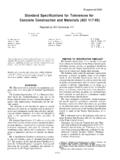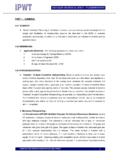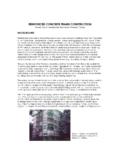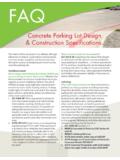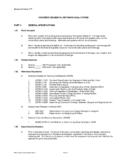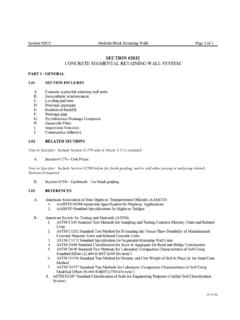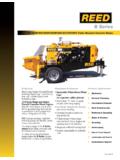Transcription of DESIGN & CONSTRUCTION CONSIDERATIONS OF …
1 DESIGN and CONSTRUCTION CONSIDERATIONS of reinforced concrete Structures for Water UtilitiesApril 12, 20071 DESIGN & CONSTRUCTION CONSIDERATIONS OF reinforced concrete STRUCTURES FOR WATER UTILITIESM aine Water Utilities AssociationApril 12, 2007 Michael E. Malenfant, & Eddy2 CONTENTS Introduction Examples of reinforced concrete structures for water utilities Advantages of reinforced concrete structures Disadvantages of reinforced concrete structures DESIGN CONSIDERATIONS CONSTRUCTION CONSIDERATIONS Summary3 INTRODUCTION In 1907, Leonard Metcalf, a Boston civil engineer whose specialty was water supply issues, and Harrison Eddy, superintendent of the sewer department in Worcester, Massachusetts, were introduced by a professor at Worcester Polytechnic.
2 Shortly thereafter, they decided to join forces and create an environmental engineering firm called Metcalf & Eddy. DESIGN and CONSTRUCTION CONSIDERATIONS of reinforced concrete Structures for Water UtilitiesApril 12, 200724 Wilmington, Delaware 10 million gallon covered water storage tank Under CONSTRUCTION , completion December 200756 DESIGN and CONSTRUCTION CONSIDERATIONS of reinforced concrete Structures for Water UtilitiesApril 12, 2007378 Atlanta, Georgia Complex of three covered water storage tanks Age from 10 years to 80 years9 DESIGN and CONSTRUCTION CONSIDERATIONS of reinforced concrete Structures for Water UtilitiesApril 12, 20074101112 Framingham.
3 Massachusetts 115 million gallon covered water storage tankDesign and CONSTRUCTION CONSIDERATIONS of reinforced concrete Structures for Water UtilitiesApril 12, 20075131415 Macon, Georgia million gallon partially buried covered water storage tank Constructed in 1920 DESIGN and CONSTRUCTION CONSIDERATIONS of reinforced concrete Structures for Water UtilitiesApril 12, 20076161718 DESIGN and CONSTRUCTION CONSIDERATIONS of reinforced concrete Structures for Water UtilitiesApril 12, 2007719 ADVANTAGES Easily adaptable to a myriad of different shapes & architectural treatments Many contractors have the capability to place reinforced concrete reinforced concrete contractor will likely already be on site Durability Proven track record of over 100 years20 DISADVANTAGES Owner preferences may dictate against using reinforced concrete Cost CONSIDERATIONS due to quantity of materials required CONSTRUCTION nuances Cracking & durability21 DESIGN CONSIDERATIONS Seismic loads Floatation Abnormal pressure loads Retaining elements Influence of
4 Adjacent / superimposed structures Integration into existing facilities Security Details, Details, Details! Liner systemsDesign and CONSTRUCTION CONSIDERATIONS of reinforced concrete Structures for Water UtilitiesApril 12, 2007822 SEISMIC LOADS23 SEISMIC LOADS24 SEISMIC LOADSD esign and CONSTRUCTION CONSIDERATIONS of reinforced concrete Structures for Water UtilitiesApril 12, 2007925 SEISMIC LOADS26 SEISMIC LOADS27 BUOYANCYP ermission is granted to copy, distribute and/or modify this document under the terms of the GNU Free Documentation License, Version or any later version published by the Free Software Foundation.
5 Photo by Sean O'FlahertyDesign and CONSTRUCTION CONSIDERATIONS of reinforced concrete Structures for Water UtilitiesApril 12, 20071028 BUOYANCY A reinforced concrete reservoir or any tank is a boat. A boat floats if designed right! DESIGN checks required: Buoyant force (uplift) on bottom slab Buoyant force causing tank to float Reduced base slab friction if tank sliding (uneven backfill) is a DESIGN consideration29 SECURITY Any reservoir requires security CONSIDERATIONS . How will the reservoir be inspected? How will venting be accomplished? Will public access be required of the top slab?
6 30 DETAILS Minimum concrete Strength Minimum Reinforcing Steel Expansion and CONSTRUCTION Joints WaterstopsDesign and CONSTRUCTION CONSIDERATIONS of reinforced concrete Structures for Water UtilitiesApril 12, 20071131 MINIMUM concrete STRENGTHS ource: ACI 350-01. Environmental Structures: Code Requirements32 MINIMUM concrete STRENGTHS ource: ACI 350-01. Environmental Structures: Code Requirements33 EXPANSION JOINTSCell 2 Cell 1 Expansion JointDesign and CONSTRUCTION CONSIDERATIONS of reinforced concrete Structures for Water UtilitiesApril 12, 20071234 EXPANSION JOINTS35 EXPANSION JOINTSGOOD LOCATIONBAD LOCATION36 CONSTRUCTION JOINTSD esign and CONSTRUCTION CONSIDERATIONS of reinforced concrete Structures for Water UtilitiesApril 12, 20071337 WATERSTOP DETAILBase slab to wall interface is most critical and most difficult to construct of all CONSTRUCTION joints:1.
7 Raised starter wall2. Bend top steel down at wall3. Drop top steel down below waterstop for entire slabOptions 2 & 3 easier to construct than option 1 but require relatively more material38 WATERSTOP DETAILO ption 1 Option 3 Option 239 WATERSTOP DETAILD esign and CONSTRUCTION CONSIDERATIONS of reinforced concrete Structures for Water UtilitiesApril 12, 20071440 CONSTRUCTION CONSIDERATIONSP roper adherence to specifications Mix DESIGN Placement Curing Details, Details, Details Integration into existing facilities41 MIX DESIGNA dding 1 gallon of water to 1 yd3of concrete will:1.
8 Increase slump about 1 inch2. Increase air content about 1%3. Increase shrinkage about 10% and increase cracking4. Reduce compressive strength about 200 psi5. Waste about 25 lbs of cement per cubic yard6. Increase shrinkage about 10% and increase cracking7. Decrease freeze-thaw durability about 20%8. Decrease wear resistance to traffic9. Increase dusting and other surface defects10. Increase time needed to finish the concreteSource: Dick Martin, Engineering Services Group, Grace Minimum permeability of the concrete will be obtained by using water-cementitious materials ratios as low as possible, consistent with satisfactory workability and consolidation.
9 Impermeability increases with the age of the concrete and is improved by extended periods of moist curing. Source: ACI 350-01. Environmental Structures: Code RequirementsDesign and CONSTRUCTION CONSIDERATIONS of reinforced concrete Structures for Water UtilitiesApril 12, 20071543 CURING44 DETAILS Waterstops & joint CONSTRUCTION Rebar cover Leak testing Backfilling procedure45 WATERSTOPSD esign and CONSTRUCTION CONSIDERATIONS of reinforced concrete Structures for Water UtilitiesApril 12, STEEL COVERS ource: ACI 350-01. Environmental Structures: Code Requirements48 REINFORCING STEEL COVERD esign and CONSTRUCTION CONSIDERATIONS of reinforced concrete Structures for Water UtilitiesApril 12, 20071749 REINFORCING STEEL COVER50 LEAK TESTINGS ource.
10 ACI Tightness Testing of Environmental Engineering concrete Unless specifically allowed by the engineer, the tank shall not be tested before all of the structure is complete and the tank s concrete has attained its specified compressive Each cell of multi-cell tanks shall be considered a single tank and tested individually unless otherwise directed by the TESTINGS ource: ACI Tightness Testing of Environmental Engineering concrete The water shall be kept at the test level of unlined concrete tanks for at least three days prior to the actual The exterior surfaces of the tank shall be inspected during the period of filling the tank.


